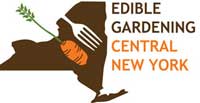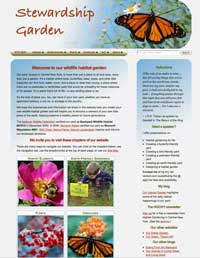Community Training in Ecological Design
Starts Sept. 10

Sponsored by Finger Lakes Permaculture Institute, The Alchemical Nursery, and Cornell Cooperative Extension
| |
Learn a land use design method to improve home scale food and forest production, conserve resources, and save money.
Study basic ecological principles and methods and use them to solve problems on your own home and landscape.
The class will meet once a week to discuss the principles and techniques of permaculture and ecology that help us make better choices for our land, families, and communities.
Class work will include a self-selected design project. You can design your own backyard, garden space, vacant lot, field, forest, or even an entire neighborhood.
Examples and applications will be presented in both an urban and rural context.
To enroll, contact any of the sponsoring organizations.
There are scholarships available. If you want to contribute to help fund scholarships, contact Frank Cetera.
|
| Interested in Edible Gardening? | 
|
If you'd like to get information on Edible Gardening CNY, just send an email to John to find out about edible gardening tours and programs.
|
|
Join HGCNY!
|  |
Becoming an official member of HGCNY is easy: just join Wild Ones! When you're a Wild Ones member, you're automatically an official member of HGCNY. |
|
Greetings!
 | Brown-eyed susan
(Rudbeckia triloba) |
Save the date for our annual plant sale!
Our annual plant sale will be on Saturday, Sept. 10 at 10 am. Details are in the article below.
 | New York ironweed
(Vernonia noveboracensis) |
Show Me, Help Me Tours
Saturday August 13 at 9 am in Westvale at my own habitat garden. RSVP to Janet to get directions.
Saturday August 27 in Jamesville - We will tour garden areas on a large rural property consisting of abandoned agricultural land and woods that have been harvested for timber over many years. RSVP to Randi, the host.
10:00 am: A long hike in the woods
11:30 am: A shorter garden tour near the house
Come to either or both.
And afterwards: You're invited to stay for a potluck picnic. Please bring your own table service, drink, chair, and a dish to pass.
 Meanwhile... Meanwhile...You can vicariously tour my own habitat garden by browsing my website Our Habitat Garden. You'll find lots of information about various creatures and how to provide habitat for them. Janet |
|
|
Guess the flower (answer below)

Hint: It's not a whale and its young ... (Answer at the end of this email.) |
|
HGCNY Plant sale:
Saturday Sept. 10, 10-noon
Our annual HGCNY plant sale will take place at the Allens (directions). Plants not sold on Saturday will still be available for sale on Sunday, Sept. 11 from 1 - 3 pm.
Check out some of the possibilities
This year we'll have plants from five of our sponsors, together with plants provided by our own members. There should be a nice variety of plants, but if there's a particular plant you'd like, contact John, and we'll see if we can have them available.
You can see some of the plants we could have available by checking the Dan Segal's Plantsmen website or Ellen Folts' Amanda's Garden website.
Tree and shrub order
This year, we're beginning a new tree and shrub procedure from Jim Engel's White Oak Nursery. Instead of ordering trees and shrubs at the plant sale, please pre-order them by Saturday, September 3, and then you'll be able to pick them up at the plant sale (or at some later time if you're not able to get them on Sept. 10).
To see what shrubs and trees are available, go to the White Oak website. The cost will be $5 more than the price listed on the website to cover delivery costs and provide HGCNY with a modest profit (this is what lets us keep this newsletter and our programs free to the public!) Send your order to John. Pay when you pick up your trees and shrubs.
Please contribute your native plants
If you have extra native (native only, please!) plants in your garden please pot them up and bring them to the sale. Please identify your plants! People providing plants or working at the sale can begin to select plants at 9:00 A.M.
Volunteers needed to return unsold plants
We're looking for volunteers to return unsold plants. We're also looking for places (schools, community gardens, etc.) that would use any unsold member-donated plants.
~ John Allen and Randi Starmer,
Plant Sale Committee |
|
The monarch: From egg to butterfly
 | | Newly-hatched monarch eating its eggshell, shown near a penny to indicate its size |
Ba Rea, a monarch researcher, has a series of six posters available that describes how a monarch butterfly transforms from a tiny egg to a beautiful butterfly. Although this poster series is an excellent resource for teachers, it's also a concise, accurate, and easily-understandable description of the whole process for anyone. Take a few minutes to read the text and you'll have a good understanding of the whole process.
(Note: She indicates that the posters seen on her website are available without the "Monroe County" title shown in the photos.)
To learn even more
If you're interested in a more detailed explanation of what actually goes on inside the chrysalis while the caterpillar is transforming into a butterfly, Journey North presents a description of the process by the world's foremost scientist on monarchs, Lincoln Brower. An audio description by Dr. Brower is included.
A brief excerpt from Dr. Brower: ...the entire internal contents of the caterpillar -- the muscles, the entire digestive system, even the heart, even the nervous system -- is totally rebuilt. It's like you took...a Ford into the shop and left it there for a week and it came out as a Cadillac.
|
|
Excellent new web resource for native plants
 | | The original guide (still available as a .pdf file) |
The Native Plant Center now has an online catalog of native plants, a continuation of the ever-popular resource Native Plants for Wildlife Habitat and Conservation Landscaping book, previously available as a pdf file (which is still available). It's a project of the U.S. Fish and Wildlife Service and the Alliance for Chesapeake Bay.
Although it is intended as a resource for the Chesapeake Bay watershed, it's still a valuable resource for us here in CNY. We're actually fairly close to this watershed, since it extends to the Cortland area, and many of the plants native to that watershed are native to our area, too. And there's no comparable online resource for our region.
You'll find this well-organized, comprehensive yet concise resource invaluable as you select plants valuable for wildlife that are suitable for your growing conditions.
|
|
The mystery flower
The mystery flower is jewelweed (Impatiens capensis), the native version of impatiens, the common bedding plant.
 | | Jewelweed (Impatiens capensis) |
Interestingly, this plant is not typically included in standard gardening reference books, even those featuring native plants. It certainly can't be because the flowers aren't attractive. Could it be because it spreads throughout the yard so joyously?
True, it does spread a LOT, but even so, it's VERY easy to pull out since its roots are so shallow--which is also why it wilts so readily in the sun, just as do the bedding impatiens.
 | | Hummingbird drinking jewelweed nectar |
But if you asked hummingbirds or bees if they'd include jewelweed in the garden, they'd say yes! Jewelweed flowers are full of nectar. In fact, they're featured in the new Native Plants Guide of the Chesapeake Bay Watershed for its wildlife value (see story above).
Another interesting property is that they're reputed to be an antidote for poison ivy. (I haven't had the need to confirm this, though.)
It's also known as touch-me-not, a reference to its method of seed distribution. When the seed pods are ripe, the least touch will trigger an explosion of seeds, one reason it spreads so readily. Kids love touching them (and so do adults even though they know they're helping spread this plant even more in the garden).
These are best planted in shade or part-shade in moist or wet conditions. Even though the plants do wilt when they're in the sun, especially in droughts, I never water them. They recover each day when they're out of the sun.
The bottom line: For me, the minor hassle of pulling out all the extra volunteers is a small price to pay for the pleasure of watching the hummingbirds and bees enjoy this plant. This may not be everyone's decision.
|
|
|
|
|